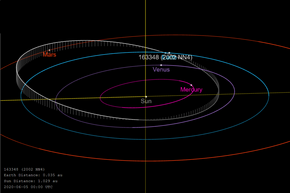 2002 NN4 orbits between Venus and Mars | |
| Discovery [1] | |
|---|---|
| Discovered by | LINEAR |
| Discovery site | Lincoln Lab's ETS |
| Discovery date | 9 July 2002 |
| Designations | |
| (163348) 2002 NN4 | |
| 2002 NN4 | |
| NEO · PHA · Aten [1] [2] | |
| Orbital characteristics [2] | |
| Epoch 31 May 2020 ( JD 2459000.5) | |
| Uncertainty parameter 0 [2] · 2 [1] | |
| Observation arc | 14.16 yr (5,171 d) |
| Aphelion | 1.2572 AU |
| Perihelion | 0.4956 AU |
| 0.8764 AU | |
| Eccentricity | 0.4345 |
| 300 days | |
| 83.774 ° | |
| 1° 12m 4.68s / day | |
| Inclination | 5.4177° |
| 259.48° | |
| 222.23° | |
| Earth MOID | 0.0069 AU (2.69 LD) |
| Physical characteristics | |
Mean diameter | |
| 14.50±0.03 h [5] [a] | |
| X [3] | |
| 20.1 [1] [2] [4] | |
(163348) 2002 NN4 ( prov. designation: 2002 NN4) is a dark, sub-kilometer near-Earth object and potentially hazardous asteroid of the Aten group that flew by Earth on 6 June 2020. The highly elongated X-type asteroid has a rotation period of 14.5 hours and measures approximately 0.7 kilometers (0.4 miles) in diameter. [2] [6] It was discovered by LINEAR at the Lincoln Laboratory's Experimental Test Site in New Mexico on 9 July 2002. [1]
Orbit
2002 NN4 flew by Earth on 6 June 2020, passing 0.034 AU (5.1 million km; 13 LD) from Earth. [2] The asteroid had been recovered two days earlier on 4 June 2020. [1] By 11 June 2020, the asteroid had brightened to apparent magnitude 14.4, which is roughly the brightness of Pluto.
Being a member of the Aten asteroids, 2002 NN4 orbits the Sun at a distance of 0.50–1.26 AU once every 10 months (300 days; semi-major axis of 0.88 AU). Its orbit has an eccentricity of 0.43 and an inclination of 5 ° with respect to the ecliptic. [2] It was first observed by the Near-Earth Asteroid Tracking on Palomar Observatory on 2 July 2002, or seven nights prior to its official discovery observation by LINEAR. [1] This asteroid has an Earth minimum orbit intersection distance of 0.0069 AU (1,030,000 km), which corresponds to 2.7 lunar distances (LD). [2]
Physical characteristics
A spectroscopic survey of the small near-Earth asteroid population conducted by European astronomers determined that 2002 NN4 is an X-type asteroid. [3] [6] Because of the objects low albedo (see below), it would be considered a primitive P-type asteroid in the Tholen classification.
Diameter and albedo
According to the survey carried out by the NEOWISE mission of NASA's Wide-field Infrared Survey Explorer, 2002 NN4 measures (735±243) meters in diameter, and its surface has a dark albedo of (0.030±0.027). [4] (The NEOWISE publication uses the designation G3348 for this asteroid. [7]) In 2016, astronomers using the European New Technology Telescope at La Silla Observatory found a diameter of 613 meters with an albedo of 0.047. [3]: 4
Rotation period
In August 2016, the first rotational lightcurve of 2002 NN4 was obtained from photometric observations over five nights by Brian Warner at the Center for Solar System Studies ( U82) in California. Lightcurve analysis gave a rotation period of 14.50±0.03 hours with a high brightness variation of 0.74±0.05 magnitude, indicative of a highly elongated shape ( U=3−). [5] [a]
Notes
- ^ a b Lightcurve plot of (163348) 2002 NN4, by Brian Warner at the Center for Solar System Studies (2016). Rotation period of 14.50±0.03 hours with a brightness amplitude of 0.74±0.05 mag. Quality code is 3−. Summary figures at the LCDB and CS3 websites.
References
- ^ a b c d e f g "163348 (2002 NN4)". Minor Planet Center. Retrieved 8 June 2020.
- ^ a b c d e f g h "JPL Small-Body Database Browser: 163348 (2002 NN4)" (2016-08-28 last obs.). Jet Propulsion Laboratory. Retrieved 8 June 2020.
- ^ a b c d e Perna, D.; Barucci, M. A.; Fulchignoni, M.; Popescu, M.; Belskaya, I.; Fornasier, S.; et al. (August 2018). "A spectroscopic survey of the small near-Earth asteroid population: Peculiar taxonomic distribution and phase reddening". Planetary and Space Science. 157: 82–95. arXiv: 1803.08953. Bibcode: 2018P&SS..157...82P. doi: 10.1016/j.pss.2018.03.008. ISSN 0032-0633. S2CID 119426280.
- ^ a b c d Masiero, Joseph R.; Nugent, C.; Mainzer, A. K.; Wright, E. L.; Bauer, J. M.; Cutri, R. M.; et al. (October 2017). "NEOWISE Reactivation Mission Year Three: Asteroid Diameters and Albedos". The Astronomical Journal. 154 (4): 10. arXiv: 1708.09504. Bibcode: 2017AJ....154..168M. doi: 10.3847/1538-3881/aa89ec. S2CID 45334910.
- ^ a b Warner, Brian D. (January 2017). "Near-Earth Asteroid Lightcurve Analysis at CS3-Palmer Divide Station: 2016 July-September" (PDF). Minor Planet Bulletin. 44 (1): 22–36. Bibcode: 2017MPBu...44...22W. ISSN 1052-8091. PMC 7243971. PMID 32455389.
- ^ a b "LCDB Data for (163348) 2002 NN4". Asteroid Lightcurve Database (LCDB). Retrieved 8 June 2020.
- ^ Plait, Phil (4 June 2020). "No, we're not in any danger from an asteroid passing Earth on Saturday night". Bad Astronomy. Retrieved 9 June 2020. (Neowise Table)
External links
- Stadium-size asteroid will safely fly by Earth tonight, Space.com
- Small Asteroid to Safely Fly by Earth, NASA
- Asteroid 163348, Small Body Data Ferret
- Discovery Circumstances: Numbered Minor Planets (160001)-(165000) – Minor Planet Center
- (163348) 2002 NN4 at NeoDyS-2, Near Earth Objects—Dynamic Site
- (163348) 2002 NN4 at the JPL Small-Body Database


